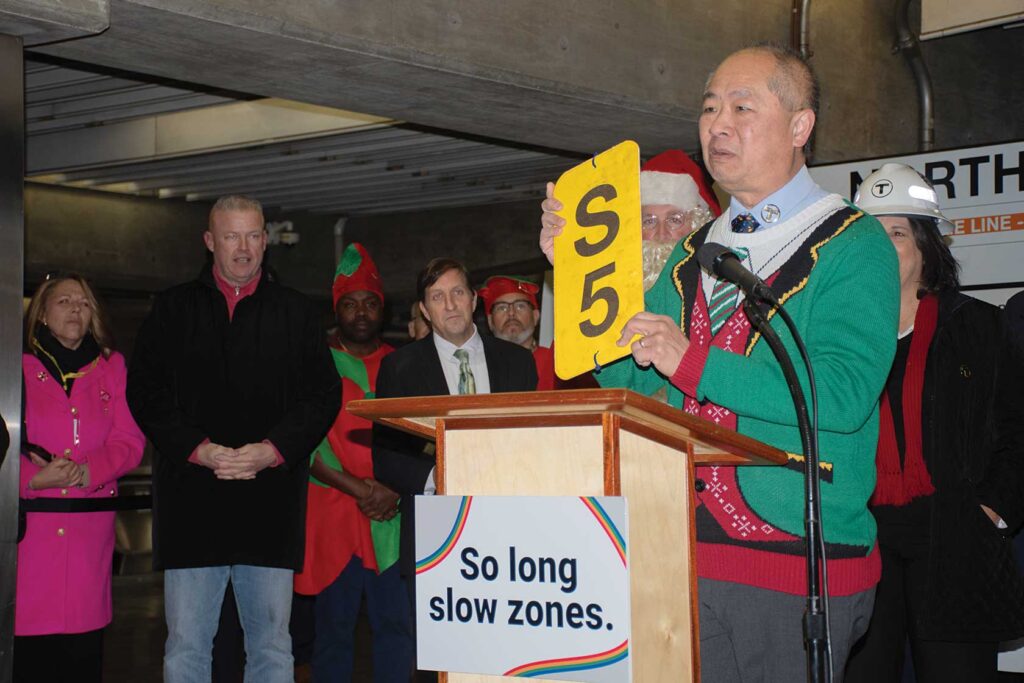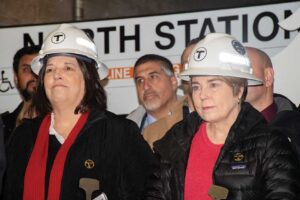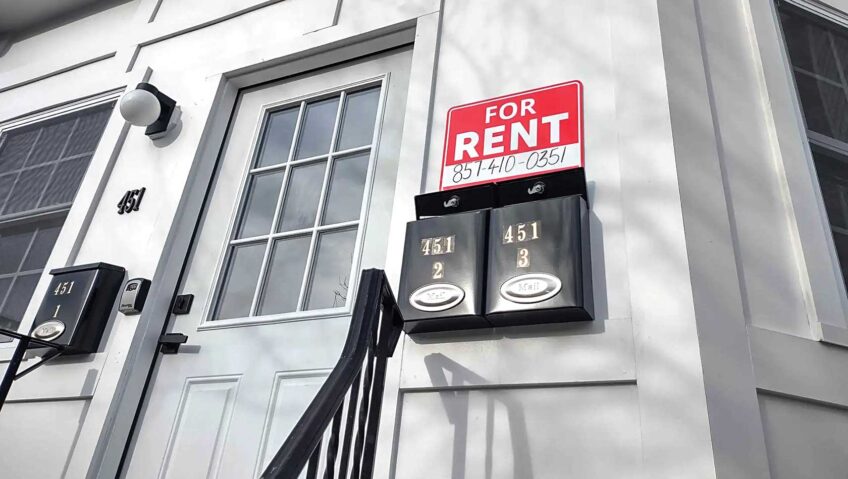
For the first time in more than 20 years, trains in the MBTA can run at full speed throughout the entire subway system.
Officials celebrated the elimination of the last slow zones — areas where wear and tear on the tracks and other problems keep trains running below full speed — at a press conference at North Station, Dec. 23.
“People are arriving on time, at full speed,” said Gov. Maura Healey at the event. “We’re getting people to where they need to go, just as the T should be.”
The event marked the end of the year-long Track Improvement Program, which saw segments of the MBTA system shut down for extended periods of time throughout 2024, making way for teams to replace 248,000 feet of track and clear out more than 200 slow zones across the system. The press conference came at the close of a 15-day closure on the Green Line.
Without the accelerated process, repairing all the slow zones would have taken years, said Lt. Gov. Kim Driscoll.
The track improvement work saw the greatest improvement on the Red Line, with about an hour saved. Overall, Healey said that riders collectively should save about 40,000 hours per week, compared to in September 2023.

Gov. Maura Healey (right) and Lieutenant Gov. Kim Driscoll wear honorary MBTA hard hats at the press conference announcing the elimination of subway slow zones. PHOTO: AVERY BLEICHFELD/BAY STATE BANNER
“Seriously, no joke, this is really awesome to see slow zones gone for the first time in 20 years, giving people back minutes, hours in their lives every week,” she said.
And those time savings should mean financial savings too. Healey said the state estimates that slow zones were costing the state $950,000 per day.
“We’re making it better for riders. We’re giving them back time in their lives. We’re getting them to where they need to go more reliably and at a faster pace, and we’re doing so in a way that benefits our economy,” she said.
The work to address speed restrictions comes as part of the agency’s response to a 2022 inspection and report by the Federal Transit Authority. That inspection came following a pattern of safety incidents — including derailments and collisions — between the start of 2019 and early 2022.
At the press conference, Joe DeLorenzo, chief safety officer at the FTA, said the completion of the track repair project marked a key moment in growth and effectiveness of the MBTA, one that he hoped would set the tone for the agency moving forward.
“It sets the tone of almost the beginning of a new era where we’re able to go forward and deal with issues, and the team is really working hard and cooperating together to improve that safety and efficiency of the T,” he said.
The new safety that officials hope will come with the repaired tracks may be less noticeable, but just as important for the system moving forward, DeLorenzo said.
“Safety, from our perspective, should be invisible to the rider. They shouldn’t be thinking about safety when they’re getting on the bus or they’re getting on the train,” he said. “The type of work that we’re seeing, and dedication of the T and the team really takes us forward in that goal.”
The work was also hailed as an example of collaboration between the many groups that make the T function — the Healey-Driscoll administration, the MBTA’s leadership, the workers who run and maintain the system, as well as local leaders.
“When you think about the T and how this actually got done, you have to think about every single worker at the T. Everybody, whether they were directly involved in the work or not, had some role in getting us to this point,” DeLorenzo said.
It has also involved collaboration to make sure that the MBTA is staffed and running, said Jim Evans, president of the Boston Carmen’s Union, which represents maintenance and repair staff, as well as transit operators and other roles in the system.
“Through our collaboration, we have ensured that the T, for the first time in a long time, is on its way to being appropriately staffed,” Evans said.
Elimination of the slow zones doesn’t mean that the system won’t ever have delays — the same morning that officials gathered at North Station to celebrate the achievement, riders on the Red Line faced delays due to a cracked rail near the JFK/UMass Station. But Healey said that, while unfortunate, some delays are to be expected in running a transit system. The delay was cleared up by 11 a.m.
“It sucks. I’m sorry anybody’s waiting right now, but we’re continuing to run a train, so from time to time there are going to be periodic issues that come up,” Healey said at the event, in response to a press question.
Phillip Eng, general manager and CEO of the MBTA, said that the elimination of slow zones through the Track Improvement Program will make it easier for the agency workers to keep the system running smoothly and avoid bigger problems in the future.
“Moving on now, we’re going to maintain the system the way it should be and build it back better for the future generation,” he said.
It was a sentiment echoed by Evans, from the Carmen’s Union.
“The completion of this ambitious agenda is only the beginning,” Evans said. “Our crews are prepared to identify and address any rail conditions that arise, with the commitment of Gov. Healey’s office.”
And completion of the track improvement program, which Healey touted as wrapping up about a week ahead of its end-of-year deadline, doesn’t mean the end of other efforts to improve service along the subway lines.
Eng said that in 2025, riders should expect the MBTA to continue ongoing work on its signal system. He said the agency is aiming to complete the upgrades on the Red and Orange Lines by early 2026, before the city is slated to host seven matches for the World Cup in June and July of that year.
That work was long-delayed, he said. but was started this year and is being accelerated.
During the press conference, Healey thanked riders for their patience during the past year of repairs and shutdowns.
“We’re going to do everything every day to continue to improve public transit so that your life is easier,” she said.
Eng, too, had a message for riders: that the MBTA should, day by day, get more reliable, and that riders should take pride in the history and character of the system.
“I want them to know that we deeply care about making their lives better every day,” he said.






